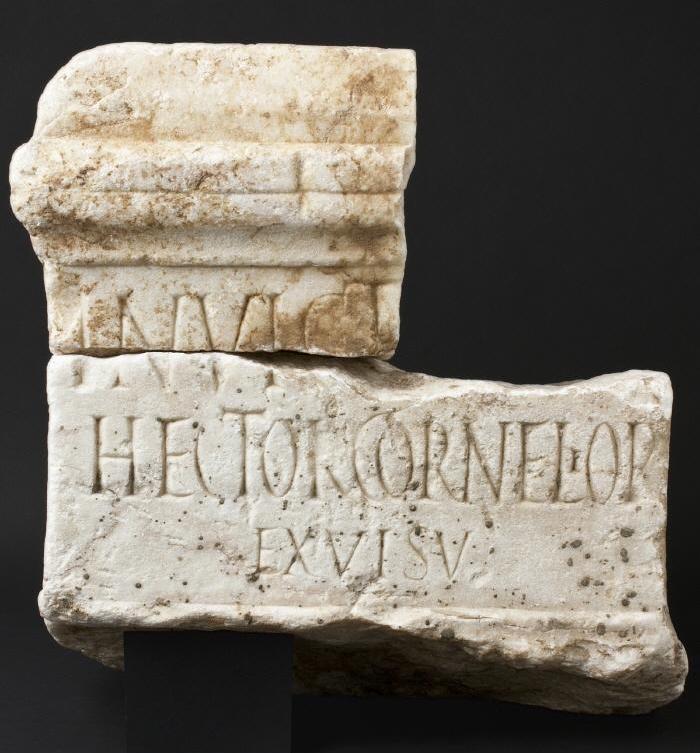
Hector Corneliorum
Hector erected an altar to Mithras in Emerita Augusta ’by means of a divine vision’, something unusual in Hispania.
Biography
of Hector Corneliorum
- Hector Corneliorum was a syndexios of the Gran mitreo de Mérida and of the Gran mitreo de Mérida.
- Active c. 2nd century in Emerita Augusta, Lusitania (Hispania).
TNMP 190
Hector is of servile origin, perhaps already a freedman at the time of his inscription. He was slave of a family of the gens Cornelia and erected the altar by means of a divine vision (ex visu), which represents an unusual case in Hispanic Mithraism. Divine epiphany is frequent in other initiatory cults, but we have no evidence of it in the cult of Mithras.
[...]
[A certain] Lucanus, together with Hector in Mérida and Sucessus and Elaine in Can Modolell, are the representatives of the servile class in the peninsular Mithraic documentation. The latter two are imperial slaves towards the end of the 1st century; the second seems to be a slave of a family of the gens Cornelia in the second half of the 2nd century; of the first we do not know with whom he maintained his relationship of dependence, but the very ability to afford an ara seems sufficient to consider that they all had a certain prosperity in their servile condition.
It would be misleading to draw hasty conclusions about the spread of Mithraism among the less favoured sectors of Hispano-Roman society. Precisely, the growing coincidence between private mithraisms and the presence of individuals in a condition of dependence accentuates the instrumental character of mithraism in the hands of the propertied class.
[...] The chronological framework in which these slaves are situated shows that their presence in the cult is prolonged throughout their existence in Hispania; consequently, we can consider that the cult is transversal, from the perspective of social stratification.
If this statement is true from the legal point of view, it may not be so evident from the economic point of view, since all of them were able to pay for an ex-voto, albeit of small dimensions in the cases of Hector and the imperial slaves, which already implies an evident filter, not only economic but also cultural.
[...]
Hector himself is known from the funerary epigraph dedicated to his wife Caesiana in which it is clear that he must be free:
Estela funeraria de Hector Corneliorum
L. Plana Torres / Archivo Fotográfico MNARM
It so happens that there is another Mithraic inscription from Icosium, in Algeria, with a similar onomastic formulation to the one under comment:
References
- Epigraphic Database Heidelberg. Altar by Hector Corneliorum of Mérida in EDH
- Epigraphik-Datenbank Clauss / Slaby. Altar by Hector Corneliorum of Mérida in EDCS
- Hispania Epigraphica. Altar by Hector Corneliorum of Mérida in HE
- Jaime Alvar (2020) ‘Mitra en Hispania: 1.01.03. Materiales procedentes de la Calle Constantino de Mérida.’ Mitra en Hispania
- Jaime Alvar (2020) ‘Mitra en Hispania: 1.01.04.01. Pequeña ara votiva de mármol blanco.’ Mitra en Hispania
Mentions
Altar by Hector Corneliorum of Mérida
TNMM 586
This fragmented altar was found in two pieces that Ana Osorio Calvo has recently brought together.
Gran mitreo de Mérida
TNMM 585
Jaime Alvar speculates that the Gran Mitreo de Mérida could have been located in this area, based on a series of materials unearthed by Mélida during the excavations of 1926 and 1927.
Gran mitreo de Mérida
TNMM 585
Jaime Alvar speculates that the Gran Mitreo de Mérida could have been located in this area, based on a series of materials unearthed by Mélida during the excavations of 1926 and 1927.


Comments
Add a comment